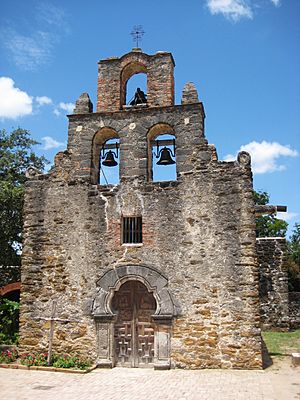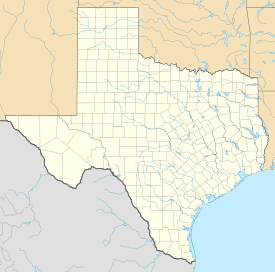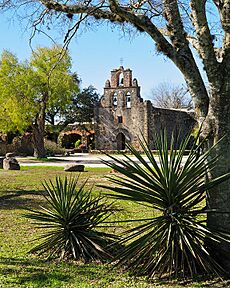Mission San Francisco de la Espada facts for kids
Quick facts for kids Mission San Francisco de la Espada |
|
|---|---|

The church of Mission San Francisco de la Espada.
|
|
| Religion | |
| Affiliation | Catholic (Roman Rite) |
| Location | |
| Location | San Antonio, Texas, U.S. |
| Architecture | |
| Architectural style | Spanish Colonial |
| Completed | Founded 1690 |
| Criteria | Cultural: (ii) |
| Designated | 2015 (39th session) |
| Parent listing | San Antonio Missions |
| Reference no. | 1466-001 |
| State Party | |
| Region | Europe and North America |
| February 23, 1972; January 28, 1974 | |
| 72001351; 74002324 | |
Mission San Francisco de la Espada, also known as Mission Espada, is an old Catholic mission. It was started by Spain in 1690. The mission was later moved in 1731 to where San Antonio, Texas is today. This area was then called northern New Spain.
The Spanish built the mission to teach local Native Americans about Christianity. They also wanted to make sure Spain controlled the land in the New World. This helped protect their claims from France. Today, Mission Espada is one of four missions that are part of the San Antonio Missions National Historical Park.
Contents
History of Mission Espada
Early Beginnings and Challenges
Mission San Francisco de la Espada was first founded in 1690. It was called San Francisco de los Tejas back then. The mission was located near Weches, Texas, southwest of present-day Alto, Texas. It was the second mission ever built in Texas. The main goal was to convert Coahuiltecan and Nabedache Native Americans.
Three priests, three soldiers, and supplies were left with the Nabedache people. The new mission officially opened on June 1, 1690. However, a smallpox sickness spread in the winter of 1690–1691. It killed about 3,300 people in the area. The Nabedache thought the Spanish had brought the disease. This caused problems between the two groups.
Drought and Abandonment
The mission faced severe droughts in the summers of 1691 and 1692. The Nabedache wanted the mission to leave. The priests felt threatened and started packing their things in the fall of 1693. On October 25, 1693, the padres burned the mission buildings. They then left and headed towards Monclova. The group got lost and did not reach Monclova until February 17, 1694.
Attempts to Re-establish the Mission
The mission was started again in the same area on July 5, 1716. This was done by the Domingo Ramón and St. Denis expedition. It was named Nuestro Padre San Francisco de los Tejas. But this new mission had to be left again in 1719. This was because of fighting between Spain and France.
Another attempt was made on August 5, 1721. It was called San Francisco de los Neches. The Nabedache were no longer interested in the mission. Also, France had stopped trying to claim land in the area. So, the mission was temporarily moved along the Colorado River in July 1730. The original site of the mission is now part of Mission Tejas State Park.
Relocation to San Antonio
The mission moved to its current spot in the San Antonio River area in March 1731. It was then renamed San Francisco de la Espada. Don Juan Antonio Pérez de Almazán, a captain, officially gave the mission to the Native Americans. These were mainly the chief of the Pacao nation. However, they were still expected to become Christians and work on the farms. They were also governed by Governor Manuel de Sandoval.
In June 1737, the Native Americans at the mission rebelled again. Only one out of 137 Native Americans remained. This was due to the harsh rules the priests had. These complaints were not listened to. As a result, all the Coahuiltecans left the mission for good.
A friary (a home for friars) was built in 1745. The main church building was finished in 1756. The mission was moved partly because Spain feared France would take their land. They also needed more missionaries for the Native American population in San Antonio de Bexar. The mission had many challenges with the Native American people. There were often rebellions.
Today, several modern churches have been designed like this mission. One example is St. Stephen's Episcopal Church in Wimberley, Texas. Some descendants of the Native American tribes from the mission are the Tap Pilam Coahuiltecan Nation and the Caddo.
Rancho de las Cabras
Rancho de las Cabras was a ranch built between 1750 and 1760. It was about 30 miles (48 km) southeast of San Antonio de Bexar. This ranch was under the control of Mission Espada. Its purpose was to provide land for growing crops and raising animals. This helped feed the mission's people without using private lands.
The ranch mostly had low fences and simple thatched buildings. These buildings were called jacales. Native workers lived in these homes. Historians believe the ranch was likely built by Native Americans who were not originally from Texas. Later, the ranch became private property. It was owned by María del Carmen Calvillo. Rancho de las Cabras is now listed separately as part of the World Heritage Site.
Espada Acequia: An Ancient Water System
The acequia (a water ditch) and aqueduct at Mission San Francisco de la Espada can still be seen today. The main ditch still carries water to the mission. It also waters the old farm lands nearby. This water is still used by people who live on these lands.
The idea of using acequias came from Romans and Moors. They brought this system to the dry areas of Spain and Portugal. When Franciscan missionaries arrived in the desert Southwest, they found this system worked very well. It was perfect for the hot, dry weather.
To bring water to the missions along the San Antonio River, Franciscan missionaries built a network of ditches. They also built dams and at least one aqueduct. This system used gravity to move water. It was about 15-mile (24 km) long. It helped water about 3,500 acres (14 km2) of land.
Gallery
See also
 In Spanish: Misión de San Francisco de la Espada para niños
In Spanish: Misión de San Francisco de la Espada para niños









